Arm Announces Mobile Armv9 CPU Microarchitectures: Cortex-X2, Cortex-A710 & Cortex-A510
by Andrei Frumusanu on May 25, 2021 9:00 AM EST- Posted in
- SoCs
- CPUs
- Arm
- Smartphones
- Mobile
- Cortex
- ARMv9
- Cortex-X2
- Cortex-A710
- Cortex-A510
New DSU-110 L3 & Cluster: Massively More Bandwidth
Alongside the new CPU microarchitectures, Arm today is also announcing a new L3 design in the form of the new DSU-110. The “DynamIQ Shared Unit” had been the company’s go-to cluster and “core complex” block ever since it was introduced in 2017 with the Cortex-A75 and Cortex-A55. While we’ve seen small iterative improvements, today’s DSU-110 marks a major change in how the DSU operates and how it promises to scale up in cache size and bandwidth.
The new DSU-110 is a ground-up redesign with an emphasis on more bandwidth and more power efficiency. It continues to be the core building block for all of Arm’s mobile and lower tier market segments.
A key metric is of course the increase of L3 cache configuration which will now go up to 16MB this generation. This is of course the high-end of the spectrum and generally we shouldn’t expect such a configuration in a mobile SoC soon, but Arm has had several slides depicting larger form-factor implementations using such a larger design housing up to 8 Cortex-X2 cores. This is undoubtedly extremely interesting for a higher-performance laptop use-case.
The bandwidth increase of the new design is also significant, and applies from single-thread to multi-threaded scenarios. The new DSU-110 promises aggregate bandwidth increases of up to 5x compared to the contemporary design. More interesting is the fact that it also significantly boosts single-core bandwidth, and Arm here actually notes that the new DSU can actually support more bandwidth than what’s actually capable of the new core microarchitectures for the time being.
Arm never really disclosed the internal topology of the previous generation DSU, but remarks that with the DSU-110 the company has shifted over to a bi-directional dual-ring transport topology, each with four ring-stops, and now supporting up to 8 cache slices. The dual-ring structure is used to reduce the latencies and hops between ring-stops and in shorten the paths between the cache slices and cores. Arm notes that they’ve tried to retain the same lower access latencies as on the current generation DSU (cache size increases aside), so we should be seeing very similar average latencies between the two generations.
Parallel access increases for bandwidth as well as more outstanding transactions seem to have been also very important in order to improve performance, which seems very exciting for upcoming SoC designs, but also puts into more question the previously presented CPU IPC improvements and exactly how much the new DSU-110 contributes to those numbers.
Architecturally, one important change to the capabilities of the DSU-110 is support for MTE tags, a upcoming security and debugging feature promising to greatly help with memory safety issues.
The new DSU can scale up to 4x AMBA CHI ports, meaning we’ll have up to 1024-bit total bi-directional bandwidth to the system memory. With a theoretical DSU clock of around 2GHz this would enable bandwidth of up to 256GB/s reads or writes, or double that when combined, plenty enough to be able to saturate also eventual high-end laptop configurations.
In terms of power efficiency, the new DSU offers more options for low-power operation when in idle situations, implementing partial L3 power-down, able to reduce leakage power of up to 75% compared to the current DSU.
In general idle situations but still having the full L3 powered on, the new design promises up to 25% reduction in leakage power all whilst offering 2x the bandwidth capabilities.
It’s important to note that we’re talking about leakage power here- active dynamic power is expected to generally scale linearly with the bandwidth increase of the new design, meaning 5x the bandwidth would also cost 5x the power. This would be an important factor to note into system power and in general the expected power behaviour of the next-gen SoCs when they’re put under heavy memory workloads.
Arm describes the DSU-110 as the backbone of the Armv9 cluster and that seemingly seems to be an apt description. The new bandwidth capabilities are sure to help out both with single-threaded, but also with multi-threaded performance of upcoming SoCs. Generally, the new 16MB L3 capability, while it’s possible somebody might do a high-end laptop SoC configuration, isn’t as exciting as the now finally expected move to a new 8MB L3 on mobile SoCs, hopefully also enabling higher power efficiency and more battery life for devices.


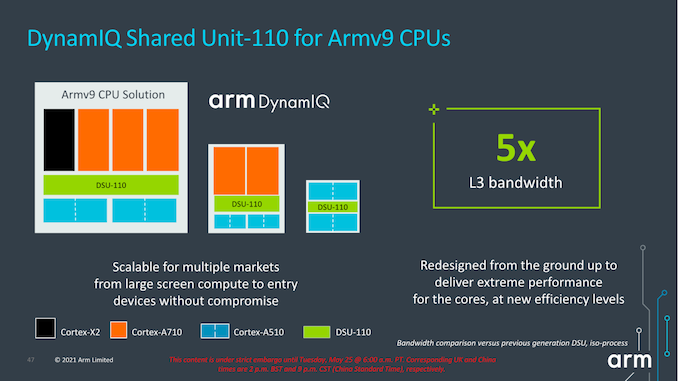
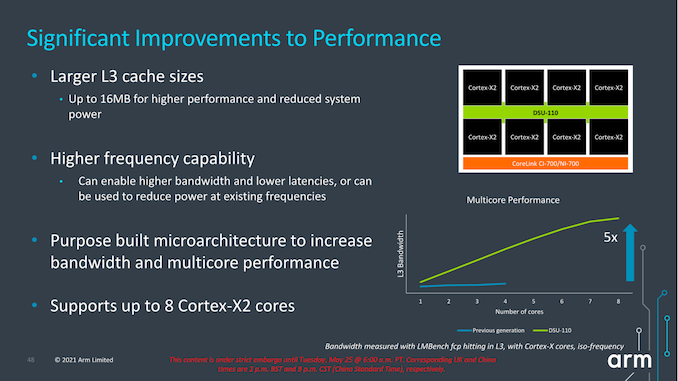
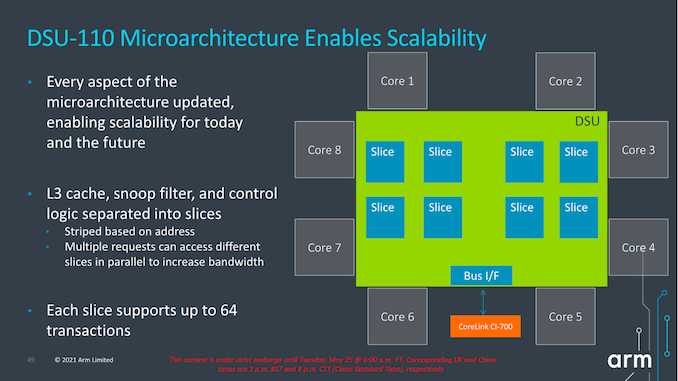
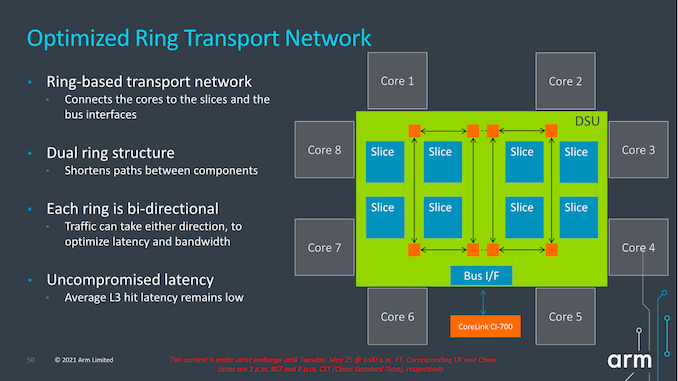
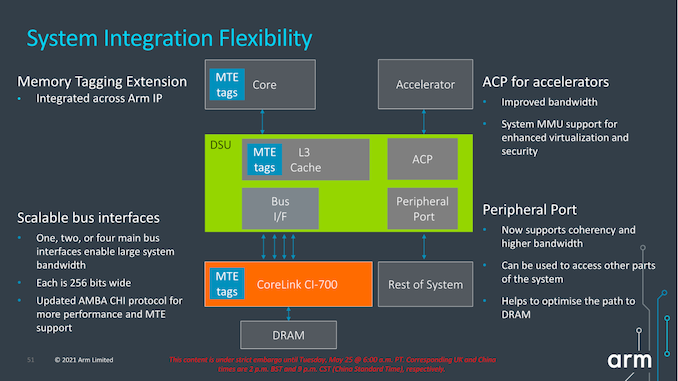

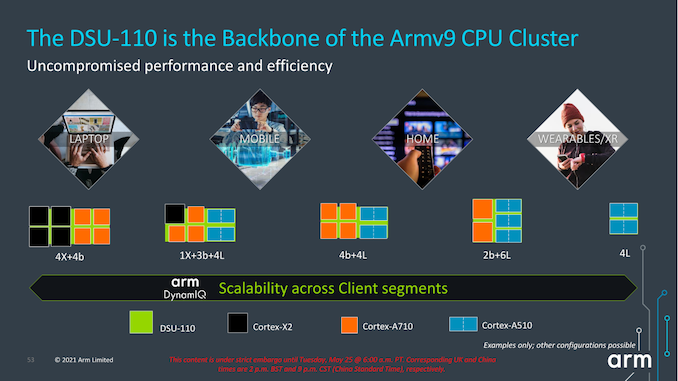








181 Comments
View All Comments
Silver5urfer - Tuesday, May 25, 2021 - link
Forgot that 32bit only thing. Apple does it everyone follows lol, on Phones the apps may be very limited for 32bit I do not know how many but some useful software might still be not updated but it might work, there is an app called DiskUsage that makes the WinDirStat type look and it's blazing fast plus works with root too. unfortunately that might be not working in the latest garbage Android 12 since it won't have storage access with SAF and Scoped disaster. There could be others..Thankfully it's not Windows which has a ton of applications on 32Bit. So pretty much some of the phones are getting outdated with this 64Bit only bs change, but since it's anyways planned obsolescence it won't matter by the time 64Bit only CPUs come like this phones which support 32bit would be dead, barring those amazing phones which have custom rom with removable batteries, they should be used for nice souvenirs if there's a DAC then like a DAP.
GeoffreyA - Thursday, May 27, 2021 - link
"Apple does it everyone follows"Popular opinion (more so when led by Apple) is like a wildfire, sweeping everything in its path.
mode_13h - Wednesday, May 26, 2021 - link
Blame consumers. Serviceable devices are more bulky and add some cost. In particular, the modular phone concept has been pursued a couple times, but never got traction.I don't like disposable hardware, but that's a sad reality of phones, tablets, and ultra-portables. I wanted to do the next best thing and use a phone with open software, but MeeGo and Firefox Phone both failed and none of the current Linux-based phone projects seem to be gaining much traction.
FWIW, my current phone does have a replaceable battery, which I had to do after the original one started swelling. It's not *easily* replaceable, but you can still do it or pay someone a little money to do it for you.
melgross - Thursday, May 27, 2021 - link
Serviceable mobile devices are also less reliable, and have smaller batteries.del42sa - Wednesday, May 26, 2021 - link
Bulldozer strikes back . LoLPS: it´s interesting design though
GeoffreyA - Thursday, May 27, 2021 - link
Shows that AMD wasn't completely bonkers.del42sa - Thursday, May 27, 2021 - link
it wasn´t a bad idea or bad arch. it was just very bad implementedusiname - Wednesday, May 26, 2021 - link
a510 vs a73 - 25% slower with 35% better power efficiency, 4 years of inovations for you.ET - Wednesday, May 26, 2021 - link
I think it's clear from the DVFS slide on the A510 page of the article that the main difference between the A55 and A510 is that the A510 can reach much higher performance with much higher power use.So yes, anyone expecting much better efficiency will be disappointed.
A510 does lead the way to pure "small core" designs that reach reasonable performance on one hand and low power on the other hand.
Still, I haven't seen a figure comparing core size, and that would be a very important measure.
mode_13h - Thursday, May 27, 2021 - link
> anyone expecting much better efficiency will be disappointed.Efficiency can come from a smaller process node. The A55 and A510 were compared at ISO-process.